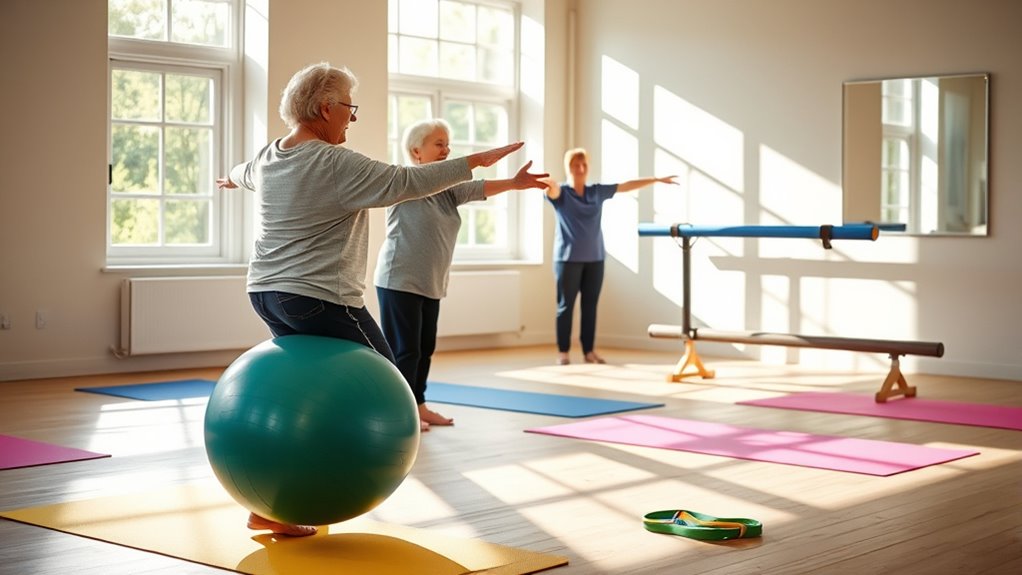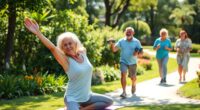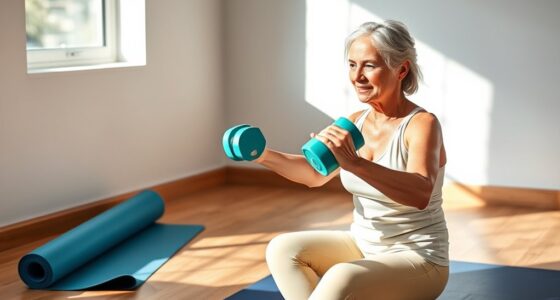Balance training is essential for keeping seniors steady and strong. Simple exercises like single-leg stands, tree poses, and lunges help improve stability and reduce fall risk. Always perform these near sturdy support, and gradually increase difficulty. It’s also key to guarantee a safe environment by eliminating hazards around your home. Regular balance exercises not only enhance mobility but also promote overall health. Keep exploring to discover more tips and strategies for adding balance training to your routine!
Key Takeaways
- Incorporate single-leg balance exercises and variations to strengthen stability and improve coordination.
- Use stable support, like a chair or wall, to ensure safety during balance training.
- Gradually increase the duration of holds and introduce dynamic movements for enhanced balance.
- Regularly review medications with healthcare professionals to minimize fall risks.
- Eliminate home hazards and maintain a clutter-free environment to promote safe movement.
Importance of Balance Training for Seniors
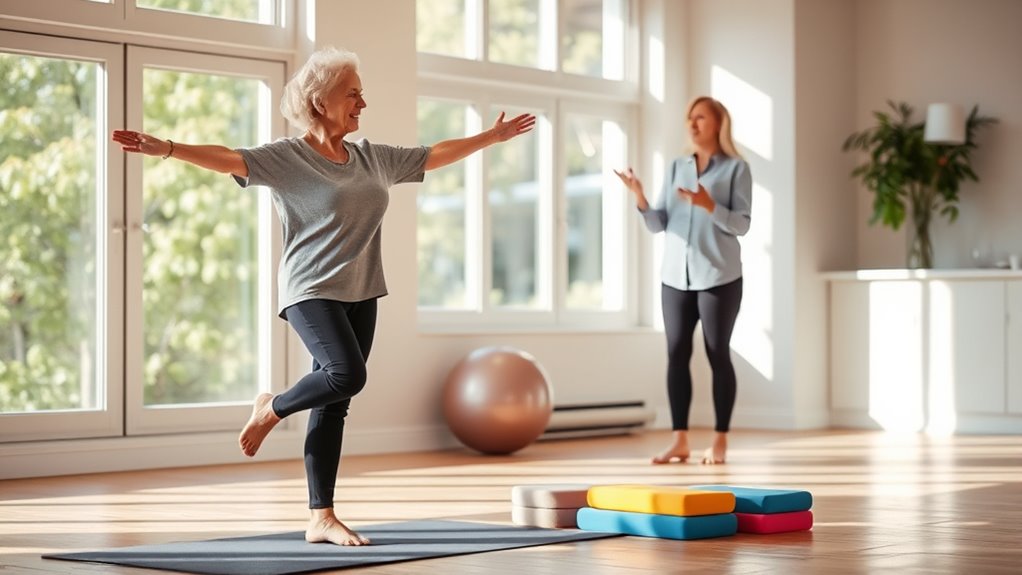
Balance training is vital for seniors, as it greatly reduces the risk of falls. Regular practice of coordination exercises can improve stability and overall mobility, making daily activities safer. Engaging in these exercises also promotes emotional and psychological growth, which is crucial for maintaining a positive mindset as one ages. Additionally, incorporating freshly squeezed juices into your diet can provide essential nutrients that support muscle function and overall health. To further enhance your balance, consider incorporating strength training exercises into your routine, as they can significantly improve muscle strength and stability. Regular veterinary check-ups for early detection of health issues can also contribute to overall well-being as we age.
Aging often results in muscle weakness and declines in the vestibular system, heightening the need for balance training to maintain independence. Engaging in these exercises not only boosts your confidence in movement but also encourages more physical activity.
In addition, consistent balance training enhances cognitive function and improves your overall quality of life, allowing you to stay active and engaged in your community. Incorporating diversification strategies in your fitness routine can also help in achieving a well-rounded approach to health.
Prioritizing balance can lead to a healthier, more vibrant lifestyle.
Recommended Balance Exercises

Now that you understand the importance of balance training, let’s explore some essential exercises you can easily incorporate into your routine. These recommended balance exercises not only boost your stability but also help you stay safe and active. Additionally, consider incorporating tools from survival gear items to enhance your training experience and provide extra support. To further improve your financial stability while maintaining an active lifestyle, consider implementing the 50/30/20 rule for budget allocation to ensure your expenses align with your health and fitness goals. Understanding the impact of assisted living expenses on your overall financial planning is essential for long-term stability. Using portable camping toilets can also improve your comfort during outdoor exercises. Incorporating motor skills activities, like using ride-on car toys, can further enhance your balance and coordination. We’ll also touch on how to progress and vary these movements to keep challenging yourself.
Essential Balance Exercises
Incorporating essential balance exercises into your routine can greatly enhance stability and coordination, which are critical for seniors.
Start with the Single-leg balance, lifting one knee and holding it for 30 seconds to improve your balance on each leg.
Next, try the Tree Pose, shifting weight to one foot while raising the opposite leg against your thigh, also holding for 30 seconds. This exercise can be particularly beneficial in promoting cognitive function as it requires focus and concentration. Regular practice of balance exercises can also support children’s well-being by providing a positive example of physical activity. Additionally, engaging in physical activities can help improve nutritional value by fostering a healthy lifestyle. It is also important to ensure a safe environment by storing any essential oils used for relaxation in dark glass bottles, which helps maintain their potency.
Lunges strengthen your lower body—step forward, bend your knee until it’s parallel to the floor, and hold.
The Flamingo Stand involves raising one leg to hip height while standing near a wall, alternating legs for added challenge.
These coordination exercises not only promote strength training but also considerably reduce the risk of falling, aiding in fall prevention. Additionally, regular veterinary check-ups can help ensure that pets remain healthy and active, which is essential for supporting seniors in their physical activities.
Safety Precautions to Follow
Here are some key safety precautions to follow:
- Always perform exercises near a stable surface, like a wall or chair, for support.
- Consult with a healthcare professional before starting any new exercise program, especially if you have existing health conditions. Newborn safety guidelines can also provide insight into maintaining a safe environment during physical activities. Additionally, maintaining a clean home can help reduce distractions and hazards that might interfere with your exercise routine.
- Make sure your exercise area is free from hazards, such as loose rugs or poor lighting. Additionally, individuals with certain conditions, such as emotional dysregulation, may need to approach physical activities with more caution due to their unpredictable responses. Engaging in music therapy can also help reduce anxiety and enhance focus during exercises.
- Listen to your body; take breaks and stop if you experience pain lasting more than a few days.
- Gradually increase the difficulty of your exercises while focusing on controlled movements.
- It’s also essential to establish clear communication channels to minimize misunderstandings, especially if you are working alongside a partner, as emotional dysregulation can impact collaborative efforts.
Progression and Variations
Building on the safety precautions you’ve taken, progression and variations in balance exercises can greatly enhance your stability and confidence.
Start by gradually increasing the duration of holds in exercises like the single-leg stance, moving from 10 to 15 seconds up to 30 to 60 seconds. You can also add variations, such as arm movements or closing your eyes, to challenge your balance further. Incorporating exercises that focus on dynamic movements can improve your overall stability and promote mental clarity in your practice. Regular practice of these exercises can also help develop gross motor skills that are essential for maintaining balance.
Incorporate dynamic movements, like the tightrope walk, to improve coordination and simulate real-life scenarios. To boost your strength, try performing exercises on unstable surfaces, such as balance boards. Camping essentials can also teach you about the importance of proper gear and safety measures for outdoor activities.
Regularly mix in new exercises, like the flamingo stand or heel-to-toe walking, to maintain engagement and motivation as you progress in your balance training.
Safety Considerations for Balance Training
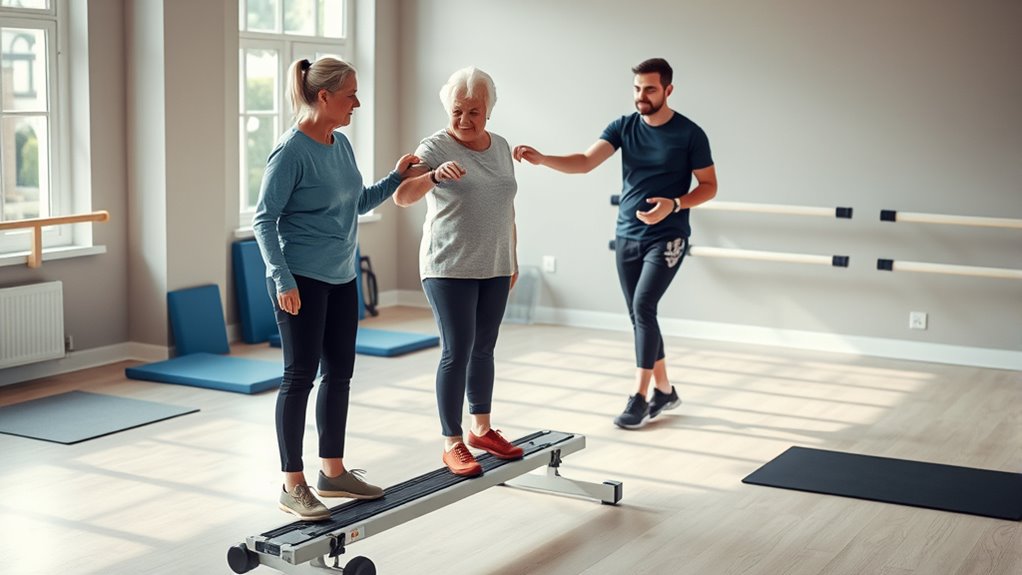
While balance training can significantly enhance your stability and confidence, it’s crucial to prioritize safety to prevent injuries. Here are some key safety considerations to keep in mind:
- Always perform balance exercises near stable support, like a wall or chair, to prevent falls.
- Take breaks during training sessions to avoid fatigue and reduce the risk of accidents.
- Consult with a healthcare provider before starting any new exercise program, especially if you have pre-existing health conditions.
- Stop any exercise that causes pain lasting more than a few days and seek professional advice if discomfort persists.
- Make certain your exercise environment is free of hazards, such as poor lighting or clutter, to minimize fall risks during training.
Benefits of Regular Balance Exercises

Regular balance exercises offer a wealth of benefits that can greatly enhance your daily life. By improving stability and coordination, you’ll find activities like walking and climbing stairs much easier. These exercises help reduce the risk of falls, a common concern for seniors, by strengthening muscles and enhancing coordination. Engaging in consistent balance training not only promotes independence but also improves your overall health and cognitive function.
| Benefit | Description | Importance |
|---|---|---|
| Stability | Enhances your ability to balance | Reduces falls |
| Coordination | Improves movement control | Aids daily activities |
| Muscle Strength | Builds stronger muscles | Supports mobility |
| Independence | Fosters self-reliance | Enhances quality of life |
Fall Risks and Prevention Strategies

Falls pose a serious threat to seniors, making it essential to understand the risks and implement effective prevention strategies. Here are some key points to contemplate:
- Conduct a medication review with healthcare professionals to identify any drugs that may increase fall risks.
- Eliminate home hazards like dim lighting and trip hazards to create a safer living environment.
- Incorporate balance exercises and strength training into your routine to enhance stability and coordination.
- Stay active to improve overall fitness, which can reduce the likelihood of injuries from falls.
- Reflect on regular check-ups with healthcare providers to monitor health changes that may affect your balance.
SilverSneakers Membership Benefits for Seniors
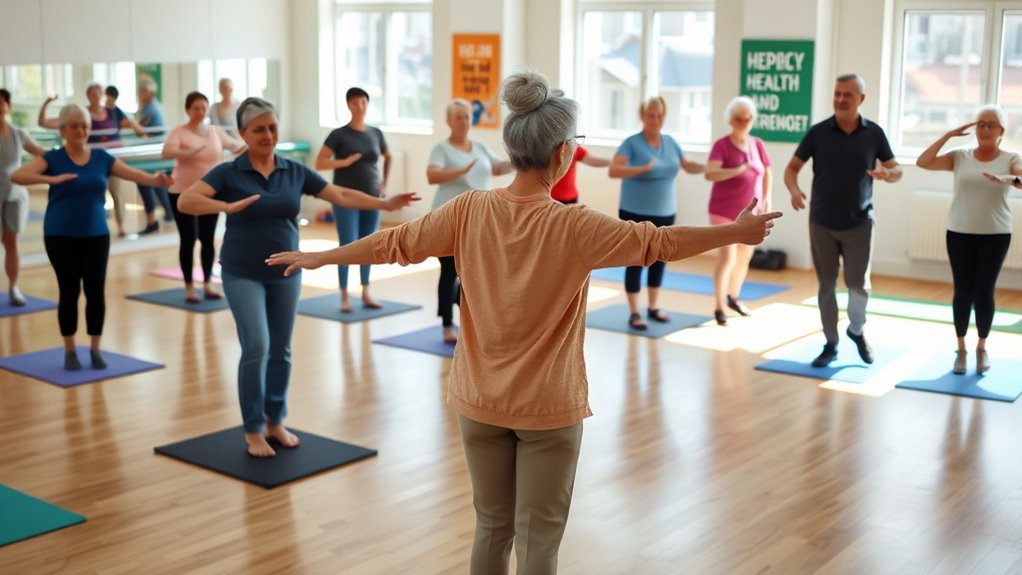
SilverSneakers membership offers seniors a fantastic opportunity to stay active and engaged in their communities.
With access to thousands of fitness locations nationwide, you can easily find a place that suits your needs. Participate in instructor-led group fitness classes designed specifically for older adults, enhancing both your physical health and social interaction.
If you prefer to work out at home, SilverSneakers LIVE online classes provide a variety of workouts at no additional cost for those enrolled in Medicare Advantage.
Plus, the membership includes a SilverSneakers ID, making it simple to explore nearby fitness options.
With access to health and wellness resources, you’ll be empowered to maintain an active lifestyle and enjoy the benefits of regular physical activity.
Additional Resources for Balance Improvement
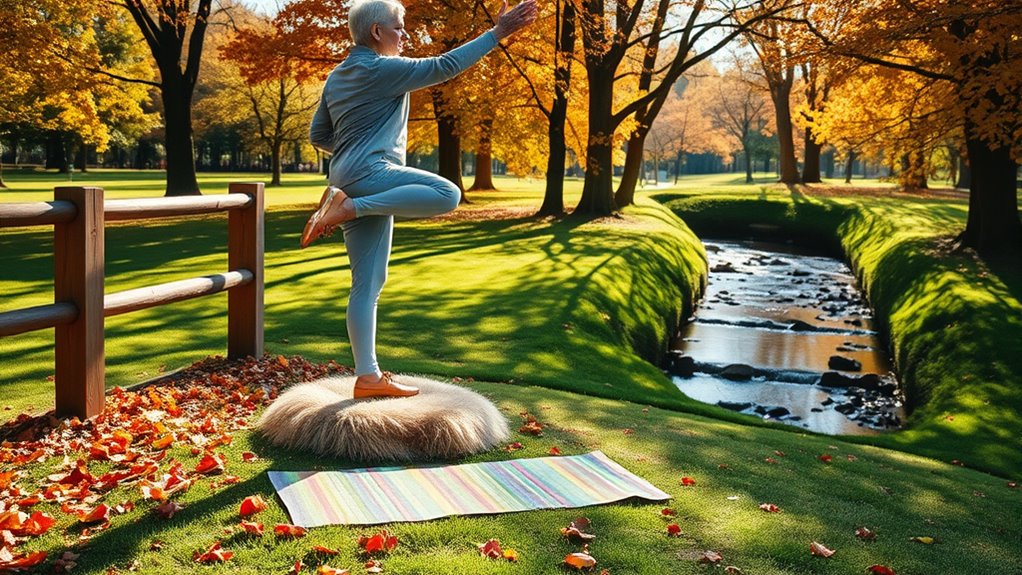
Staying active through programs like SilverSneakers opens the door to additional resources that can help you improve your balance.
Here are some effective options:
- Structured balance training programs: Join classes designed for older adults to enhance your stability.
- Balance and coordination exercises: Incorporate simple daily activities to strengthen your core and improve coordination.
- Online resources: Access video demonstrations of Exercises To Improve Balance, which guide you through proper techniques.
- Consulting with healthcare providers: Talk to a physical therapist for personalized recommendations tailored to your needs.
- Preventing falls: Learn safety tips and strategies to reduce your risk of falling.
Frequently Asked Questions
What Is the Number 1 Exercise to Increase Balance in Seniors?
The number one exercise to boost your balance is the single-leg stand. By holding this position for just 30 seconds, you can enhance your core stability and lower body strength, greatly reducing the risk of falls.
You can easily modify it by using a chair or wall for support, making it accessible no matter your fitness level. Practicing this exercise consistently will improve your overall mobility and independence in daily activities.
What Is the Number One Exercise for Seniors?
You mightn’t realize it, but the simplest actions you take daily can hold the key to your strength and stability.
The number one exercise for seniors is the Sit-to-Stand. This exercise helps you build leg strength and improve balance by repeatedly shifting from sitting to standing.
Aim for 10 repetitions, and you’ll notice the difference in your mobility. It’s an excellent way to enhance your independence and reduce the risk of falls.
Can an Older Person Improve Their Balance?
Yes, you can definitely improve your balance as an older adult! Engaging in regular balance exercises, like single-leg stands or tai chi, can enhance your stability and coordination.
Even if you’re over 70, consistent practice can lead to noticeable improvements in your balance and mobility. Just dedicating 30 minutes a week to these exercises can boost your physical performance, reduce the risk of falls, and increase your confidence in daily activities.
How Do You Maintain Body Balance in Old Age?
To maintain body balance in old age, you should engage in regular balance exercises that strengthen your core and lower-body muscles.
Activities like tai chi or yoga not only enhance your physical stability but also improve mental coordination.
Incorporating simple exercises, such as single-leg stands or heel-to-toe walking, into your daily routine can make a significant difference.
Don’t forget to consult with your healthcare provider to tailor your exercise program to fit your individual needs.
Conclusion
By incorporating balance training into your routine, you’re not just enhancing your stability; you’re embracing a stronger, more active lifestyle. Imagine confidently maneuvering your home or enjoying a stroll in the park without fear of falling. With the right exercises and safety precautions, you can considerably reduce fall risks and improve your overall well-being. So, why not take that first step today and invest in your balance for a healthier tomorrow?

